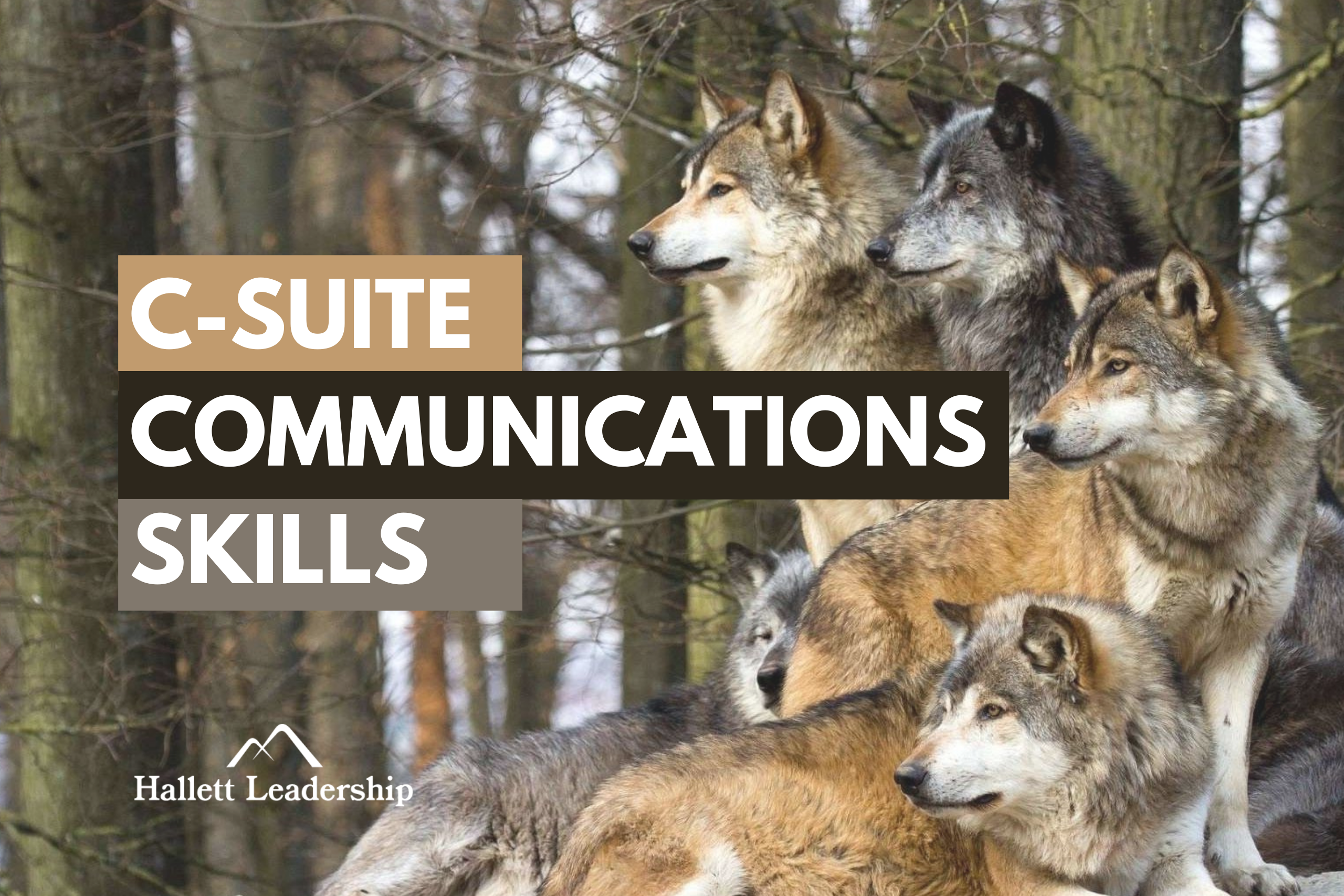Perhaps at the start of this article on C-suite communications skills, you’re expecting to read a bulleted list of items on communications skills the executive needs to succeed.
There certainly are C-suite communications skills, but instead of presenting you with a list, let’s explore them within a holistic context.
After all, anyone occupying a c-suite position, or in the process of ascending the ladder toward one, will neither express nor develop their communications skills in a one-off manner, but rather as part of an integrated set of behaviors.
Therefore, rather than studying a list, developing C-suite communications skills is best achieved by identifying and modeling the people with the best C-suite communications skills.
Who are these people?
Authentic leaders.
And if the authentic leader is the paragon of c-suite communications skills — then just how do they communicate?
How do they show up?
Let’s explore just how an authentic leader shows up… and how they communicate in ways that engage people, and foster the development of high-performance cultures.
Beginning With Emotional Intelligence
We all love data these days. We live in a data-rich environment. We attend to what the CRM software and surveys tell us about what to do next, for whom, when, and in what quantity, our expected ROI, and in how much time…
This emphasis on data would be sufficient if we were interacting only with machines. And if we were machines ourselves.
But we are not interacting only with machines. And we are not machines.
In the workplace, we primarily interact with people.
This means that in order to excel, we must be familiar with operating in human terrain — the terrain of emotion and instinctive response.
Emotional intelligence indicates a person’s degree of comfort with understanding and navigating their own and other people’s emotional and instinctive responses.
The Authentic Leader has considerably developed emotional intelligence.
This emotional intelligence lies at the heart of effective C-suite communications skills.
Non-Verbal Communications Matter… Tremendously
Human connection generally, and emotional intelligence specifically, rely heavily on the senses to perceive non-verbal signals and cues.
During interactions, we rely upon our sight of others’ body language, facial expressions; we attune to the sound of their voices, and the tone of those voices.
Therefore the Authentic Leader’s communications skills, driven by emotional intelligence, depend greatly upon mastery of non-verbal signals and cues.
In order to become most receptive to non-verbal signals and cues, the authentic leader enters an interaction inquiring:
“How can I connect most effectively with this person right now?”
The question opens the awareness of the person who asks it, so that they become receptive to all clues and data points in their environment, to the words and the content of the words the other is speaking — and also to the other’s non-verbal cues and signals.
The Authentic Leader wields emotional intelligence to gather up all verbal and non-verbal sensory data… but for what?
To respond most effectively. To engage in the most meaningful way at the present moment.
Authentic Leadership Requires Understanding What’s Important In The Moment
How could we define an Authentic Leader, given what we’ve explored so far?
An Authentic Leader is a person who utilizes advanced emotional intelligence in order to identify and engage what they perceive as the most effective approach in the moment — regardless of the outcome.
Since “doing” things in the c-suite has less to do with executing tasks and more with thinking, listening, and delegating (i.e. communicating), we can see that authentic leadership is largely a role of communicating and interacting with other people.
Therefore, we can see why emotional intelligence is so primary to the C-suite leader’s continuing success.
Authentic Leadership may also be showing up to interactions in a way that expresses:
“I am genuinely interested in and actively listening to what you say.”
Authentic Leadership may also be about being honest when we don’t know something, and modeling humility and trust in the moment by saying to the person, or people at the meeting:
“Look, I really don’t know… what do you think?”
Authentic leadership, as we mentioned above, is about being willing to show up, regardless of the outcome. It communicates:
“I’m present, here in the moment, with you and here for you, listening. I care about what’s going on.”
The Authentic Leader may often not be required to manifest spontaneous insight and brilliance, but instead to serve as a sounding board for the person they’re communicating with.
The Authentic Leader, like a martial arts master, expresses what the moment requires… not only in deed, but in their style of communicating.
The Authentic Leader Is A Versatile Communicator
The Authentic Leader doesn’t need to fall back to their dominant style of communicating with every person. After all, people vary in their communications styles.
One person may prefer to “hear it straight.”
But another person may desire to feel supported, witnessed, or “seen” in the process of receiving feedback during their annual review.
Knowing this, the Authentic Leader can move into any communication style according to the person they are interacting with — no matter what their default communication style may be.
Expressing this versatility, it’s important to note that the Authentic Leader does not lose who they are and become manipulative.
They are simply able to show up and treat others not as they themselves want to be treated — but to treat others as those others would prefer to be treated.
One person wants to “hear it straight” so they can get back to their task. Another person wants to be encouraged and built up.
To each according to their primary communications style.
To give an example, an Authentic Leader whose default mode of behavior is introverted, develops and practices communications skills more common to extroverts, in order to connect more effectively with people who prefer such an approach.
As an accountant and introvert at the beginning of my career, I had to learn how to interact — when necessary — in more extroverted ways, in order to form more effective relationships with some people.
The Authentic Leaders Put Themselves Out There
Finally, the Authentic Leader is resolved to put more of themselves out there, regardless of the outcome.
They are willing to risk being wrong, instead of withholding their opinions.
While in many cases it’s important to remain discreet about what’s on our minds, there are many, many occasions on work teams when the group could really benefit from hearing what’s on the boss’s or any team member’s mind.
For example, a C-suite leader requiring better performance from their team might keep silent and come to certain conclusions about team members and then begin firing, reassigning, and hiring without consulting with the group.
Or the leader can engage in Authentic Leadership, bring the group together into the same room, humbly, and say:
“Guys, I really care about this company, and I don’t know what’s going on… but I sense a lot of complacency in the room. Let’s talk about it.”
At the heart of this conversion about c-suite communications skills, we can see that an Authentic Leader demonstrates a willingness to address an important but uncomfortable issue, and show up in a way that’s real, or authentic.
Now, Let’s Talk about Ways to Improve C-Suite Communication Skills
Strong C-suite communication skills help leaders connect with employees, investors, and stakeholders. It builds trust, ensures alignment, and creates a positive company culture.
Limit Confusing Language
Clear communication is one of the most important skills for C-suite leaders. Using complex words, technical jargon, or vague statements can confuse people and slow decision-making.
Good leaders know how to simplify their message without losing meaning. They explain ideas in a way that is easy to understand, whether they are speaking to employees, investors, or board members. When information is clear, teams can act faster, work more efficiently, and avoid misunderstandings.
Being clear also builds trust. When people understand what is expected of them, they feel more confident in their roles. Leaders who use straightforward language create a culture where communication is open, transparent, and effective.
Know the Audience
Great leaders adjust their communication style based on who they are speaking to. Employees, board members, and investors all have different needs, so messages must be tailored to each audience.
Employees want leaders to be clear, motivational, and supportive. They need direction and reassurance, especially during times of change. Investors and board members, on the other hand, want financial insights, strategic plans, and clear business goals.
When leaders take the time to understand their audience, their message becomes more effective. It ensures that people get the right level of detail and that information is meaningful to them. Adapting communication builds trust, credibility, and stronger relationships.
Listen and Respond
Communication is not just about talking — it’s about listening. Great leaders know that paying attention to others is just as important as delivering their own message.
Listening helps executives understand the needs of employees, customers, and investors. It allows them to catch problems early, hear new ideas, and make informed decisions. Leaders who listen actively show that they value input, which helps build stronger relationships and trust.
But listening alone is not enough. Leaders must also respond thoughtfully. Acknowledging concerns, asking follow-up questions, and providing solutions all help strengthen communication. When people feel heard and respected, they are more engaged and motivated to contribute.
Stakeholder Reporting
C-suite leaders must keep stakeholders informed, whether they are investors, board members, or regulators. Clear, structured reporting is a key part of C suite communication skills. Executives must provide timely updates to investors, board members, and regulators to ensure alignment with company goals. When reporting is done well, it makes planning and execution smoother for the entire organization.
Reports should be easy to understand, well-organized, and focused on what matters most. While financial data and key performance indicators are important, leaders should also provide context. Explaining the numbers and how they connect to company strategy helps stakeholders see the bigger picture.
Communication in Mergers and Acquisitions
Mergers and acquisitions are major business events that create uncertainty. Employees, investors, and customers all want to know what’s happening, how it affects them, and what to expect next.
Without clear communication, rumors and misinformation can spread quickly, creating confusion and anxiety. Leaders must provide consistent updates, explain the reasons behind the merger, and outline expected changes. People who understand the transition feel more secure and focused on their roles.
Transparency is key. Leaders should answer questions openly, address concerns, and reassure employees about their future in the company. Strong communication during mergers helps maintain morale, align teams, and ensure a smoother integration process.
Conclusion
With excellent c-suite communications skills, we discover an integrated mode of behavior that we have named Authentic Leadership. The Authentic Leader is the individual who develops emotional intelligence, and a wide range of communications styles and behaviors for the sake of having a greater connection and influence with the most people possible.





